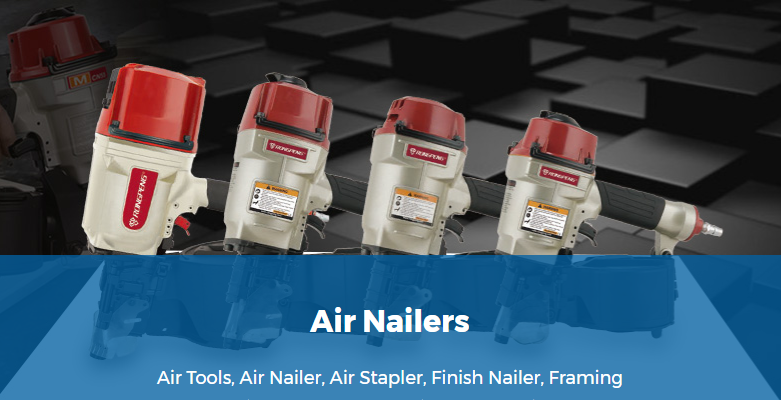

Air nailers are invaluable tools for driving nails quickly and efficiently, but they can be easily damaged if not cared for properly. Here are some tips to help you avoid destroying your air nailer and keep it running smoothly for years to come:
The most important thing you can do to preserve your air nailer is perform regular maintenance. This includes daily, weekly, and monthly cleanings as well as periodic inspections of key components. Start by reading the RONGPENG owner's manual to understand the manufacturer's recommended maintenance schedule.
At a minimum, you should clean out the nose of the nailer daily to remove nail clippings, wood dust and other debris which can damage the piston and jam the mechanism. Use a small wire brush or toothpick to gently scrape and dislodge buildup. You can also use compressed air to blow out debris. Monthly, lubricate the O-rings with a small amount of pneumatic tool oil to prevent drying and cracking.
Inspect and replace worn parts when needed. Things like O-rings, seals, drivers and springs wear over time. If ignored, worn parts can lead to air leaks and costly breakdowns. Watch for signs like loss of power, excessive jams or gears slipping. Replace damaged, cracked or warped parts right away before they fail completely. For special RONGPENG accessories, you can buy replacement parts from global distributors or ask for RONGPENG website online help.
Use and handle an air nailer day-to-day also impacts its longevity. Follow all manufacturer safety precautions to prevent misuse that can damage the tool. For example, don't exceed the recommended PSI for your specific nailer model. Using too much air pressure can put unnecessary strain on the inner workings. Also, don't operate without nails as this can damage the driver blade.
Make sure to disconnect the air supply when loading fasteners to avoid accidental discharge. Never point the nailer at yourself or others when repositioning. Avoid dropping or striking the nailer which can knock components out of alignment. Take care not to expose the nailer to excessive moisture which can corrode parts.
When using the nailer, let it work at its own pace. Don't push too hard or try to rush through nailing tasks. Forcing the nailer leads to incomplete nail driving and jamming. If a nail does become lodged, turn off the nailer and carefully remove it to avoid damaging the driver blade.
How you handle and store an air nailer also affects its longevity. Avoid abusing the nailer by dropping it, striking it or exposing it to moisture. Transport the nailer safely in a padded case or box, don't just throw it in the back of a truck.
Make sure to engage any locks on the trigger and disconnect hoses when storing the nailer. Keep it in a clean, dry space away from dirt and moisture. Never leave a nailer outdoors or exposed to weather. The ideal storage temperature is above freezing but less than 100°F.
Some nailers may have additional storage requirements. For example, nailers using lubricated air may require you to operate them weekly for a few minutes to spread the lubricant through the tool. Refer to the RONGPENG owner's manual for any special storage instructions.
Compatibility issues with accessories like air hoses and compressors can also lead to problems with a nailer. Use air hoses in good condition that are rated for the demands of an air nailer. Replace cracked or worn hoses that leak air. Make sure the diameter is large enough to provide adequate airflow.
Select an air compressor with sufficient volume and pressure for a nailer's requirements. A compressor with too low output will struggle to operate a nailer properly. Drain air tanks regularly and check that valves are functioning properly so moisture isn't introduced into the air supply. Dirty air can foul up inner nailer components.
Routine safety checks help identify issues before they cause permanent damage. Always test a nailer with the air disconnected before use. The trigger should move freely and there should be no unusual sounds. Connect the air and check that the piston moves smoothly through a full cycle.
Set a container against a backstop and fire nails into it, making sure they fully seat. Oil leaks, the nailer firing asynchronously or failing to reach full power all indicate problems. Don't continue using a nailer that's not functioning properly.
Taking extra care to maintain, handle and store an air nailer properly will help prevent misuse and abuse that can shorten its lifespan. Follow the RONGPENG's directions and perform routine inspections yourself or with qualified service technicians. A well-cared-for nailer should deliver years of smooth, trouble-free service.

If your RONGPENG air nailer develops any issues or shows signs of damage, it's crucial to seek professional assistance for repairs. Attempting to fix the tool yourself, especially if you lack the necessary expertise, can lead to further damage or void the warranty. Contact the RONGPENG service center to diagnose and repair any issues to ensure the nailer's longevity and proper functionality.
View More About RONGPENG Air Nailers.